THE BAUMEISTER ORGAN OF MARIA IMMACULATA MAIHINGEN (D)

Pictures/Videos

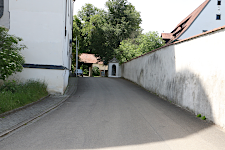
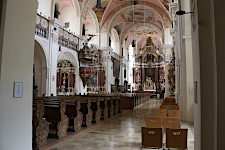
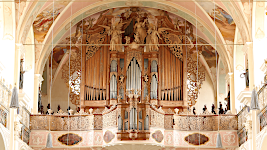
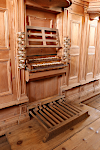
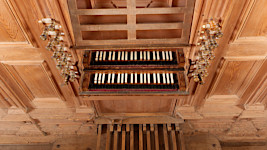
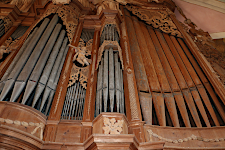
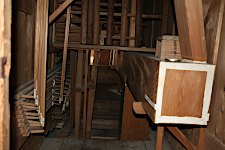
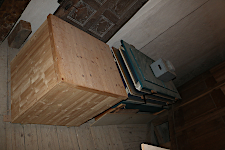
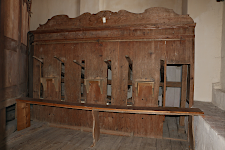
Sound examples (of the virtual organ)
Anton Estendorffer (1670-1711): Galliarda Octabi Toni and variations (07:24)
RP demo (53-63-69): Muffat, Gottlieb (1690-1750): Toccata prima und Verseti in d-Moll (05:48)
HW demo (53-63-69): Muffat, Gottlieb (1690-1750): Toccata Seconda und Verseti in g-Moll (05:43)
Wolfgang Ebner (1612-1665): Pieces from 56 Versetten durch die acht Kirchentöne (20:03)
Johann Speth (1664-1721): Toccata Prima - Erstes Musikalisches Blumenfeld (04:00)
Description
According to Die Baumeister-Orgel von 1737 in der Klosterkirche Maihingen1, this unique organ was built by Johann Martin Baumeister from 1734 to 1737, with the exception of the Rückpositiv which is attributed to Jakob Philipp Bouthellier. What makes it so special is that, due to an incredible combination of fortunate circumstances, it is almost perfectly preserved, including its original voicing2: In the course of the secularisation of the monastery of Maihingen, the instrument was sealed in 10/1802 and no longer used as masses where then held in the nearby parish church Mariä Himmelfahrt. In addition, Baumeister did not equip the organ with an entrance - an inconvenience which appears to have prevented potential attempts to perform maintenance work for a long time. Thus, when the organ was finally opened and restored from 1988-1990, it was de facto still in its original state as built and voiced bei Baumeister.
The restoration was carried out very carefully, and it was exceptionally well documented. The goal was to make the organ playable while working on it as little as possible so as to preserve its original state.
Having remained in its original state, its sound is unusual for today's ears, and, as Christoph Bossert demonstrates3, one needs to take one's time and get involved with it.
Patricularly noteworthy are the incredibly beautiful 8' flute, string and Quintatön stops, including the Cythara 8' which is a celeste stop to be used together with Flauten 8' for a tremulant like effect.
How to get the FREE 14 DAY TRIAL: Please log in to your MyPROSPECTUM account (or create and activate it if you do not yet have one). Once you are logged in, you can create your personal PROSPECTUM license and download/install the Maihingen trial installation package. Next, go to https://hauptwerk-organ.com/shop/, scroll down to Sample Sets of PROSPECTUM Virtual Organs and order your free iLOK trial license code. Install it on your iLOK dongle as usual.
For extensive information about the organ (unfortunately all in German only), please have a look at
Specification
| Hauptwerk |
|
|
| |
|
|
| Bordon Copel |
16' |
|
| Principal |
8' |
|
| Spitzflauten |
8' |
|
| Quintatön |
8' |
|
| Gamba |
8' |
|
| Salecinal |
8' |
|
| Octava |
4' |
|
| Quint |
3' |
|
| Superoctav |
2' |
|
| Mixtur IV |
1' |
|
| Cymbel III |
1/2' |
|
| |
|
|
|
| Rückpositiv |
|
|
| |
|
|
| Copel |
8' |
|
| Cythara mit der Flauten allein |
8' |
|
| Flauten |
8' |
|
| Principal |
4' |
|
| Quint |
3' |
|
| Gembshorn |
2' |
|
| Mixtur III |
1' |
|
| |
|
|
| |
|
|
| |
|
|
| |
|
|
| |
|
|
|
| Pedal |
| |
|
|
| Principalbass |
16' |
|
| Subbass |
16' |
|
| Octavbass |
8' |
|
| Quintbass |
6' |
|
|
|
|
|
|
|
|
|
|
|
|
|
| Abzug (HW-PD) |
|
|
| Schiebekoppel RP-HW |
|
|
| Koppel RP-PD |
|
|
| |
|
|
|
|
|
|
|
Tuning : Modified meantone, f(a')=427.7 Hz. Deviation from equal temperament (cents): |
 |
About this virtual organ
The recordings for this sample set have been made using reference quality equipment and methods based on almost 20 years of experience. Processing was done using our new high quality VPOlab© system based on 17 years of experience in digital signal processing algorithms research and development. The result is a high quality sample set that sounds close to what is achievable with the dry+IR approach but can still be used like any conventional wet sample set.
This sample set introduces several innovations:
- No denoising applied - sound details preserved A special processing toolchain eliminates the need for denoising and therefore avoids denoising related quality losses
- High quality reverb using hundreds of carefully recorded and optimized IRs of the Klosterkirche, all rendered into the samples using a specially developed rendering engine. The HW convolution engine is not used/required.
- Up to 7 release samples per pipe The number of releases and their corresponding tone lengths were determined individually for each pipe depending on its speech to minimize playing artifacts.
Highlights of this virtual organ
- The famous, exceptionally well-preserved Baumeister organ of Klosterkirche Maihingen
- Size: Two manuals, pedal, 22 stops
- Keyboard ranges extended to 56/30 keys
- Wet sample set with 6 channel sound (direct, indirect, church) for extensive adjustment possibilities (listening position and overall sound). Created using hundreds of optimized IRs of the Klosterkirche (HW convolution engine not required).
- No denoising applied - no denoising related loss of sound details
- Up to 7 release samples per pipe: More natural sound, playing artifacts substantially reduced compared to conventional wet sets.
- Sample resolution: 24bit/48kHz stereo
- Action noises (keys, stops etc.) and blower noise (can be switched on/off) included
- Carefully designed wind model of the Baumeister organ
- Single/dual portrait/landscape registration screens to fit all consoles
- Comes with 2 temperaments: The original Maihingen temperament obtained by analysis of the samples and the official temperament of the organ as published by Hopfenzitz 1990.
Graphical User Interface
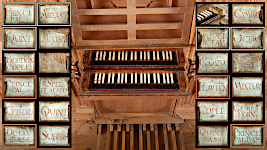
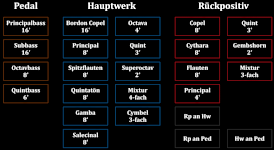

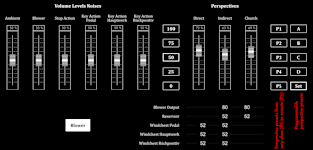
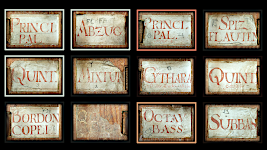
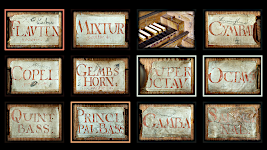
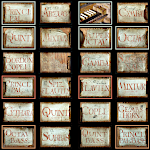
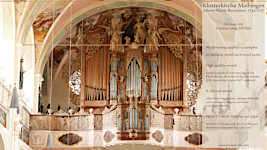

Requirements
- Hauptwerk versions: 4, 5-6, 7-8
- RAM (24bit, 2/4/6 channels): 7.1 / 13.1 / 18.7 GB
- RAM (20bit, 2/4/6 channels): 6.3 / 11.8 / 17.3 GB
- RAM (16bit, 2/4/6 channels): 4.1 / 7.1 / 10.2 GB
- RAM (24bit, 6 channels, uncompressed): 33.5 GB
Latest version 1.08